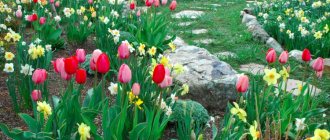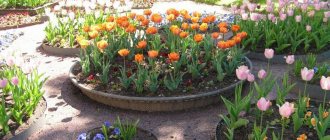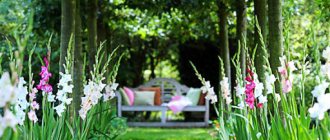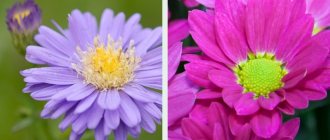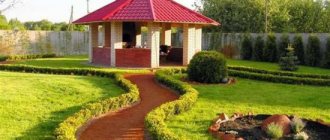- Flowerbed arrangement
- Combination of species
- Delayed flowering
- Grouping by height
- Nice flowers for the neighborhood
- Planting plants in the ground after tulips
- Plants that should not be planted nearby
Gardeners and lovers of growing flowers strive to use the space on their site as efficiently as possible. If you have a flower bed with tulips, the problem arises of combining them with other flowers, which will delight you with their bright buds not only in the spring, but also throughout the summer months. Let’s deal with the problem of what to plant between tulips and list suitable options.
Tulips in landscape design
Traditionally, the described crop is planted in flower beds. One landscape composition may contain plants with flowers of the same color scheme or different shades.
The described crop is often grown in planting arrays, where other bulbous plants are also placed, for example, daffodils, muscari, hyacinths. Common ways of using the described plant are in mixborders, ridges, on alpine hills, rocky gardens, and in borders.
Did you know? Today, 92% of all international trade in tulip bulbs is controlled by the Netherlands. 88% of all tulip plantations are located in the same state.
Landscape designers recommend growing the described crop in the following ways:
- In groups: in the same color scheme, using contrasting shades, with a smooth transition from light to rich colors.
- By height: flowers are placed in such a way that none of them obscures the neighboring plant, or in steps - tall ones are located in the background, medium-sized ones are in the center, low ones are in the foreground.
- In containers: pots can be placed at the entrance to your home or placed around the garden.
Mobile flower garden
The mobile flower garden is not tied to a specific location. Plants are planted in large containers, pots and flowerpots. Each element becomes a module that is used for decoration. In landscape design, roses are placed:
- along the edges of the paths;
- near houses;
- on the terraces.
Dwarf patios can be hung in planters in a gazebo or on a tall tree in a seating area. For a rose garden in the country, old garden carts or baby strollers are used. Large plants have a massive root system, so patio, mini and polyanthus varieties are used for landscaping. To prevent crops from getting sick, they cannot be constantly moved.
Source ogorod.ru
Roses in landscape design are often placed next to bodies of water. Compact fountains or small pools with a strict geometric shape are suitable for a mobile flower garden. Containers are placed around the perimeter of the sides or installed in a bowl.
What plants to plant with roses for the background
The structural design of the rose garden at the dacha creates a clear picture in the garden. The flower is the canvas and the lawn is the frame. Plants in the phase of throwing out buds look most advantageous against a background of greenery. The inclusions are relevant for borders, parterres and alpine flower beds. A base with a bright emerald tint helps to highlight the texture of the structures.
Square plots for rose gardens on a large plot Source bonjourparis.com
The rose occupies a central place in landscape design. The remaining plants emphasize the importance of ornamental culture. Leartis and lavender will form the background. On the lower tier, periwinkle creates a pleasant green carpet with blue stars. The perimeter of the flower bed is decorated with bells and aquilegias.
The rose garden at the dacha is fenced off with barriers. Juniper will protect the plant from the wind and highlight the beauty of the flower. Compact thuja and spruce trees will be good neighbors. Evergreen magnolias, cotoneaster and pyracantha will not disturb the composition. A spectacular beauty will make friends with lilac and privet bushes.
Beautiful surroundings of the house with lush floweringSource landshaftdizajn.ru
In landscape design, roses are combined with hosts. Decorative foliage of low-growing species is collected in lush rosettes. A kind of border hides the unsightly parts of the bushes. If you fill the lower tier with marigolds, you can additionally protect the flowerbed from diseases and insects. The following is used as a fence:
- cosmos;
- nasturtiums;
- gaillardia.
Petunias and gypsophila look good with light varieties. A mixed rose garden in the country is often collected from bulbous species. In early spring there will be primroses, daffodils and tulips in the flowerbed, then lilies. In order not to spoil the neighborhood with the main plant, you need to trim off the wilted greenery.
Tall roses are the central element of a floral arrangement. Source pinterest.com
Tulips in the garden, at the dacha
When cultivated in garden plots, the described flowers are planted in the trunk circles of fruit trees (apple trees, cherries, plums) and shrubs. If this option is not suitable, then a separate area should be set aside for this crop. For many years, row planting has also been used in gardens. To do this, the garden plot is divided into zones and in each of them one variety is planted in a row.
Did you know? For the first time, residents of the Middle Eastern countries began to cultivate tulips. In the 11th century, this plant was a symbol of the culture of the Seljuk tribe.
When dividing a garden into zones, rectangular monoflower beds are also used. The territory of the site is divided into sectors, in each of which flowers are planted in the same color scheme. Such segments combine harmoniously with each other. They enclose the zones with climbing plants. An effective technique is to plant several varieties with different species in clumps in the form of a vernissage along the path.
In addition, you can lay ceramic decor - figured figurines, tiles, etc.
Since perennial onions are combined with tulips, it is good to combine these crops in the garden beds. If the territory of the dacha is large, then the described crop can be allocated a separate corner in the depths of the garden. In the spring, during flowering, it will become a bright spot against the background of young foliage of trees, and in the summer, after losing its decorative effect, it will be hidden behind the greenery of large plants.
Another interesting element is a multi-level flowerbed. It is done by planting tall varieties in the background, medium-growing varieties in the center, and dwarf varieties in the front and along the edges.
It is also possible to plant tulips in the form of a winding path. For such an element, flowers of the same variety and tone, or the same variety, but in contrasting shades, are suitable. The edges should be planted with small plants that shade the tulip path.
Flower beds from perennials: features of creating flower beds from perennial flowers
A bright, dense flower bed will only be possible in a lighted area. To correctly create a composition, you need to select plants in advance and imagine the appearance of each specimen at different times of the year.
Perennials are plants to decorate your garden that grow for more than two years, bloom beautifully or have decorative foliage.
Transforming a garden is a labor-intensive process that requires constant presence in the garden beds. Before you start working with soil, you should consider the following nuances:
- Soil features. Each flower has its own type of soil;
- Climate. Emphasis should be placed on pure varieties and hybrids that take root well in the planting region; Terrain. You can make a beautiful flower bed on a flat surface, on a slope, or in a lowland. A certain type of plant is suitable for each option;
- Illumination. Not all colors are suitable for a sunny area. Species that love partial shade are best planted in a flowerbed near the fence, next to tall bushes;
- Planting density. It is necessary to maintain a certain distance for each plant in the circle of neighboring flowers; Flowering dates. In order for the flowerbed to delight with color throughout the summer season, varieties should be selected with different flowering periods and durations.
Where is the best place to plant tulips?
At a summer cottage, the crop usually takes place in a flowerbed in front of the windows or the central entrance. It is also planted near an artificial reservoir.
Find out also how to grow tulips in a greenhouse by March 8th.
This flower is also suitable for planting under a garden bench.
An interesting solution would be to install not a traditional wooden bench, but a plastic one, maybe even a transparent one. Another favorite way to grow flowers is along paths.
Video: Unusual planting of tulips
What do tulips go with?
In group plantings, the described crop is recommended to be grown together with the following plants:
- hosta and other perennials with large leaves;
- daylilies;
- phlox;
- geranium;
- steppe almond, holly mahonia, Japanese spirea and other ornamental shrubs;
- common lilac;
- daffodils;
- hyacinths;
- ferns;
- muscari;
- cereals;
- coniferous.
These plants look very impressive when planted against the backdrop of a smoothly trimmed lawn. They are often used for borders - in such a composition they use a combination of tulips with other plants, usually flowering ground covers, as well as tall perennials, which are able to “cover” the flowers after they have lost their decorative effect.
When composing border compositions with tulips, in order to prolong its decorative effect, plants with a short flowering period are planted in baskets, which are removed after flowering. And in their place, “later” annuals are placed.
Tulip planting patterns
There are many examples of how to plant the described flowers in an original and beautiful way. Below are the most popular of them.
| Scheme 1. Composition shape: rectangular, square, round, corner. | Plants: thuja occidentalis Smaragd, holly mahonia, hostas, tulips with an average flowering period, preferably with double petals of yellow or orange color (Monte Carlo, Sensual touch). |
| Scheme 2. Form of composition: rabatka. | Plants: Darwin hybrids, simple early tulip, Rembrandt-, Triumph-tulip, Armenian muscari. |
| Scheme 3. Form of composition: elongated flower bed. | Plants: hosta, sedum, liatris, tulip, peony, loosestrife, rhizomatous geranium, gaillardia, crocus. |
| Scheme 4. Form of composition: round raised flower bed. | Plants: Konica spruce, rugosa rose, Fortune euonymus, boxwood, juniper, iris, hosta, lavender, hybrid daylily, tulip, Japanese barberry. |
What to plant tulips with so that the flower bed blooms all summer
You can select ornamental plants in such a way that the area looks decorative for a long period. This is achieved by planting crops with different flowering periods and different heights next to each other.
Thus, when the inflorescences of some plants fade, the buds of others will bloom. This order can be achieved if you plant flowers with early, middle and late flowering periods in the flowerbed, and also select herbaceous crops with a long period of preservation of decorative leaves.
Important! Tulips should be grown in the same area for no more than four to five years. In order for them to continue to delight with abundant flowering in the future, they need to be transplanted to another place.
Tulips have a short flowering period - no longer than three to four weeks. The earliest varieties (Christmas Marvel, Montrex, New Design) bloom at the end of April, the middle ones (Denmark, Havran, White Dream, Barcelona) - in mid-May, and the late ones (Finola, Statement, Orange Angelica, Cafe Naur) - at the end of May . By planting 8–10 bulbs of each of these varieties, you can ensure that the flowerbed will delight you with lush flowering for 1–1.5 months.
To ensure that the flower garden remains decorative in the future, you can plant the following plants:
- host;
- astilbe;
- Brunner;
- forget-me-nots
It is these plants that begin to bloom when the tulip buds dry out. If bulbs are dug up, then salvia, aster, marigolds, lobelia, and ageratum can be planted in their place.
So, the use of tulips on the site allows you to obtain beautiful and original decorative compositions. You can come up with unusual planting schemes yourself or use ready-made solutions. In order for flowers to be healthy and grow well, it is necessary to carry out proper planting and provide timely, high-quality care.
What they like and don't like
So, having decided on the bulbs, you can also choose a place to plant the flower garden. In this case, it is necessary to take into account the requirements and characteristics of the flower culture.
Since these flowers are of Asian origin, they prefer the following habitats:
- warm, well heated;
- solar;
- protected from the winds.
Also, the selected area for the flower bed should be protected from waterlogging. Bulbs rot quickly in wet soil.
But the soil for them should be:
- sandy loam;
- wet;
- loose;
- rich in humus;
- slightly alkaline or neutral;
- well drained.
All this must be taken into account when choosing a site for planting a flower bed. It is better to choose a place where potatoes, legumes or cabbage were previously grown.
